Search Result
Results for "
Cardiomyopathy
" in MedChemExpress (MCE) Product Catalog:
2
Isotope-Labeled Compounds
| Cat. No. |
Product Name |
Target |
Research Areas |
Chemical Structure |
-
- HY-139465
-
|
CK-274; CK-3773274
|
Myosin
|
Cardiovascular Disease
|
|
Aficamten (CK-274) is a potent cardiac myosin inhibitor with an IC50 of 1.4 μM. Aficamten can be used for the research of hypertrophic cardiomyopathy (HCM) .
|
-
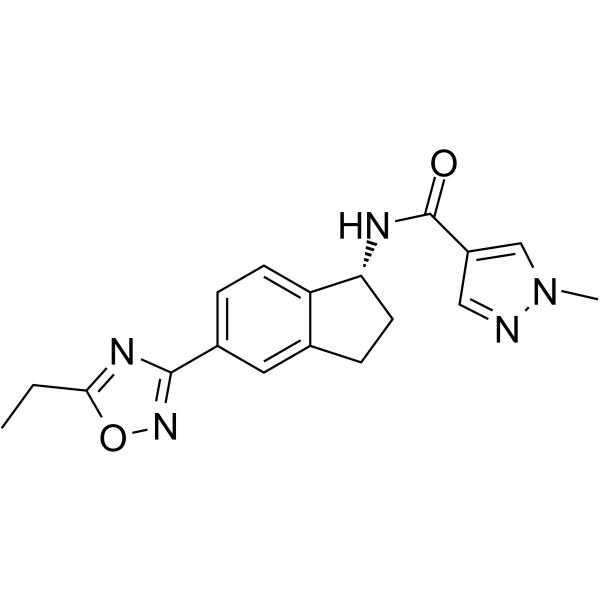
-
- HY-121744
-
PS10
2 Publications Verification
|
PDHK
|
Inflammation/Immunology
|
|
PS10 is a novel, potent and ATP-competitive pan-PDK inhibitor, inhibits all PDK isoforms with IC50 of 0.8 μM, 0.76 μM, 2.1 μM and 21.3 μM for PDK2, PDK4, PDK1, and PDK3, respectively. PS10 shows high affinity for PDK2 (Kd= 239 nM) than for Hsp90 (Kd= 47 μM) . PS10 improves glucose tolerance, stimulates myocardial carbohydrate oxidation in diet-induced obesity. PS10 has the potential for the investigation of diabetic cardiomyopathy .PDK: pyruvate dehydrogenase kinase
|
-
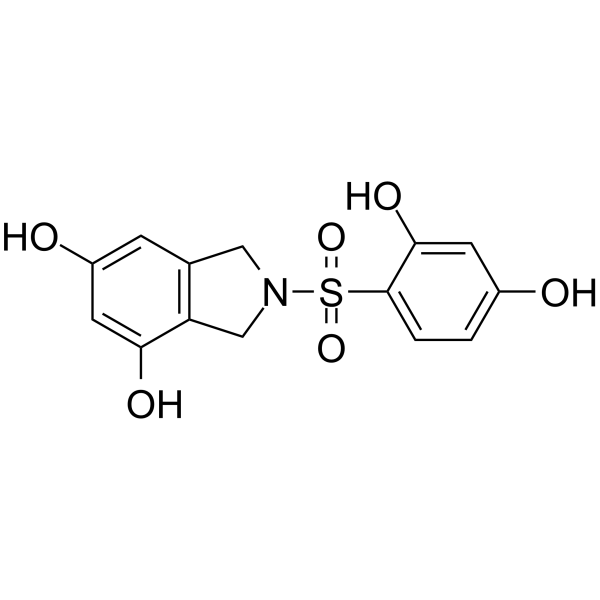
-
- HY-152190
-
|
|
Myosin
|
Cardiovascular Disease
|
|
JB002 is a myosin II inhibitor, with an IC50 of ≤10 μM. JB002 can be used for the research of muscle spasticity, chronic musculoskeletal pain, and hypertrophic cardiomyopathy .
|
-
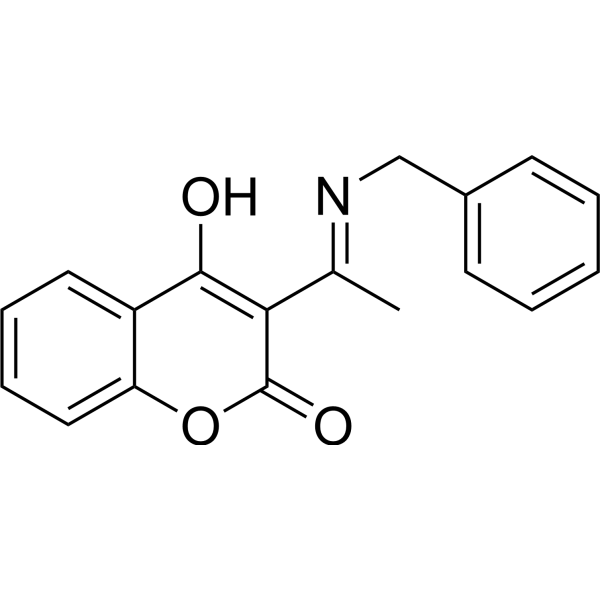
-
- HY-145564A
-
|
PF-07265803 hydrochloride
|
p38 MAPK
|
Cardiovascular Disease
Inflammation/Immunology
|
|
Emprumapimod (PF-07265803) hydrochloride is an orally active and selective inhibitor of p38α MAPK. Emprumapimod hydrochloride can be used for the research of dilated cardiomyopathy and acute inflammatory pain .
|
-

-
- HY-150040
-
-
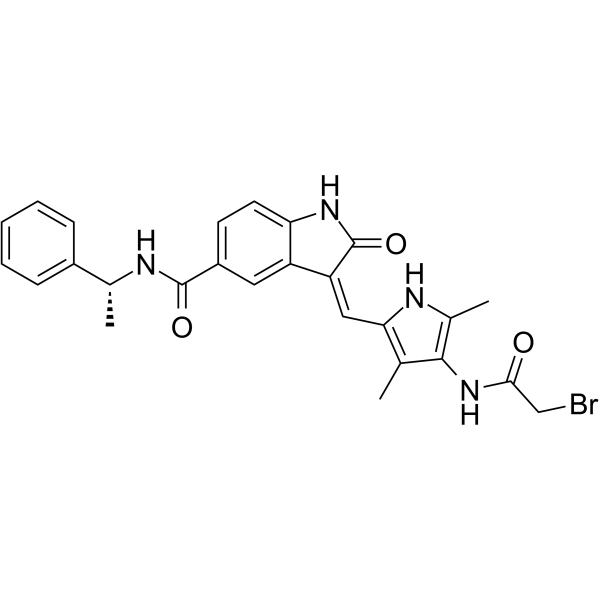
-
- HY-106577
-
|
Cifenline; Ro 22-7796
|
Potassium Channel
|
Cardiovascular Disease
|
|
Cibenzoline is a potent inhibitor of KATP channel with directly affecting the pore-forming Kir6.2 subunit rather than the SUR1 subunit. Cibenzoline is a class Ia antiarrhythmic agent. Cibenzoline has little anticholinergic activity. Cibenzoline markedly attenuate LVPG which has a close relationship with myocardial contractility decreasing. Cibenzoline has the potential for the research of hypertrophic obstructive cardiomyopathy .
|
-
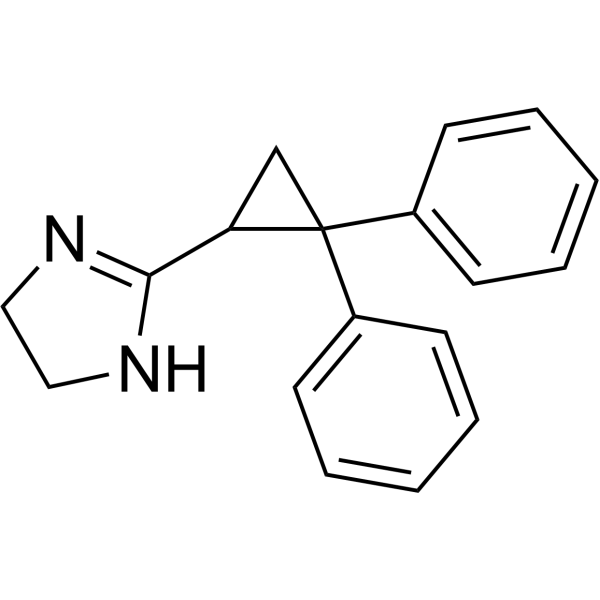
-
- HY-145564
-
|
PF-07265803
|
p38 MAPK
|
Cardiovascular Disease
Inflammation/Immunology
|
|
Emprumapimod (PF-07265803) is a potent, orally active and selective inhibitor of p38α MAPK directly inhibits LPS-induced IL-6 production from RPMI-8226 cell (IC50=100 pM). Emprumapimod can be used for the research of dilated cardiomyopathy and acute inflammatory pain .
|
-
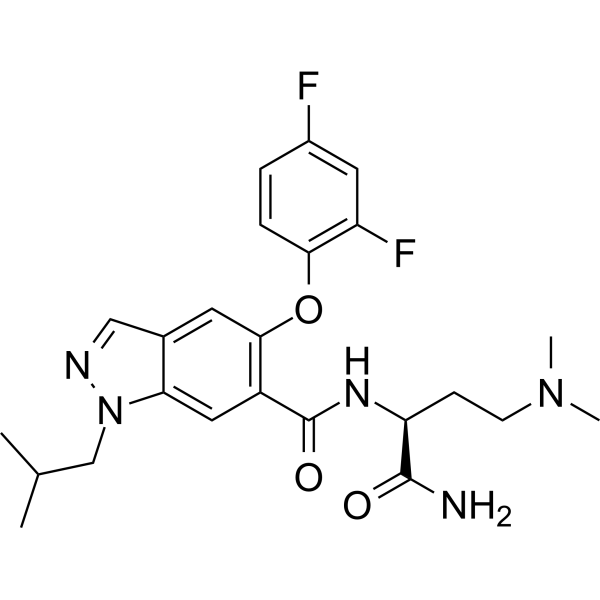
-
- HY-105218
-
|
BMS-180291
|
Prostaglandin Receptor
|
Cardiovascular Disease
Endocrinology
Cancer
|
|
Ifetroban (BMS-180291) is an orally active antagonist of thromboxane A2 (TXA2) or prostaglandin H2 (PGH2) receptor. Ifetroban shows antiplatelet activity, and inhibits tumor cell migration without affecting cell proliferation. Ifetroban can be used for myocardial ischemia, hypertension, stroke, thrombosis, cardiomyopathy research .
|
-
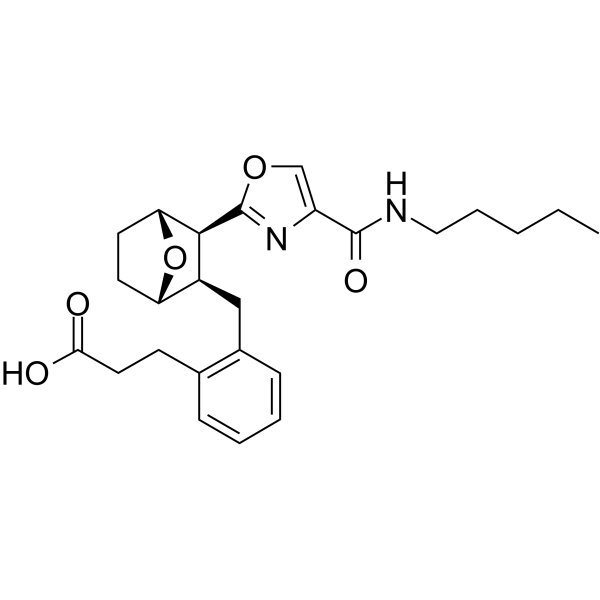
-
- HY-105218A
-
|
BMS-180291 sodium
|
Prostaglandin Receptor
|
Cardiovascular Disease
Endocrinology
Cancer
|
|
Ifetroban (BMS-180291) sodium is an orally active antagonist of thromboxane A2 (TXA2) or prostaglandin H2 (PGH2) receptor. Ifetroban sodium shows antiplatelet activity, and inhibits tumor cell migration without affecting cell proliferation. Ifetroban sodium can be used for myocardial ischemia, hypertension, stroke, thrombosis, cardiomyopathy research .
|
-

-
- HY-103320A
-
|
|
CaSR
|
Metabolic Disease
|
|
Calhex 231 hydrochloride is a potent negative allosteric modulator that blocks (IC50 = 0.39 μM) increases in [ 3H]inositol phosphates elicited by activating the human wild-type CaSR transiently Ca 2+-sensing receptor. Calhex 231 hydrochloride can be used in the study of traumatic hemorrhagic shock (THS) and diabetic cardiomyopathy (DCM) .
|
-

-
- HY-152206
-
|
|
Myosin
|
Neurological Disease
|
|
JB062 is a nonmuscle myosin inhibitor with IC50 values of 1.6, 5.4, and >100 μM for Skeletal muscle myosin, Cardiac muscle myosin, and Smooth muscle myosin II, respectively. JB062 has cytotoxic to human cancer cells but not normal cells. JB062 can be used in research of muscle spasticity, chronic musculoskeletal pain, and hypertrophic cardiomyopathy .
|
-
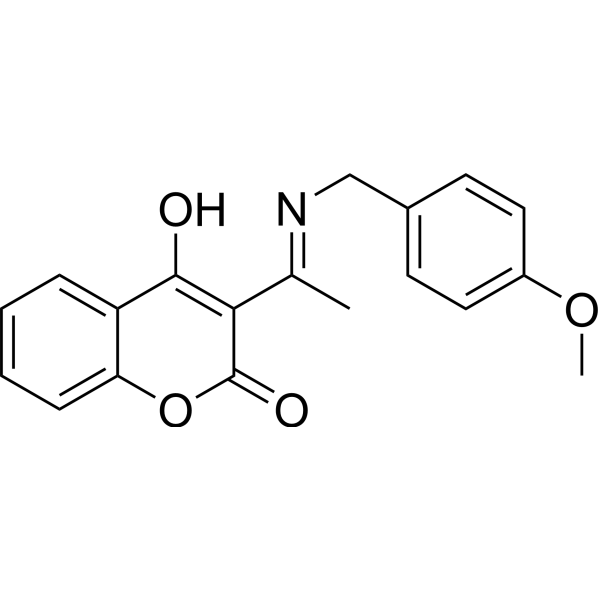
-
- HY-103320
-
|
|
CaSR
|
Metabolic Disease
|
|
Calhex 231 is a potent negative allosteric modulator that blocks (IC50 = 0.39 μM) increases in [ 3H]inositol phosphates elicited by activating the human wild-type CaSR transiently Ca 2+-sensing receptor. Calhex 231 can be used in the study of traumatic hemorrhagic shock (THS) and diabetic cardiomyopathy (DCM) .
|
-

-
- HY-103320B
-
|
|
Others
|
Metabolic Disease
|
|
(1R,2R)-Calhex 231 hydrochloride is the isomer of Calhex 231 hydrochloride (HY-103320A), and can be used as an experimental control. Calhex 231 hydrochloride is a CaSR inhibitor via negative allosteric modulation. Calhex 231 hydrochloride blocks Ca 2+-induced accumulation of [ 3H]inositol phosphate with an IC50 of 0.39 μM in HEK293 cells. Calhex 231 hydrochloride has the potential for diabetic cardiomyopathy (DCM) treatment .
|
-
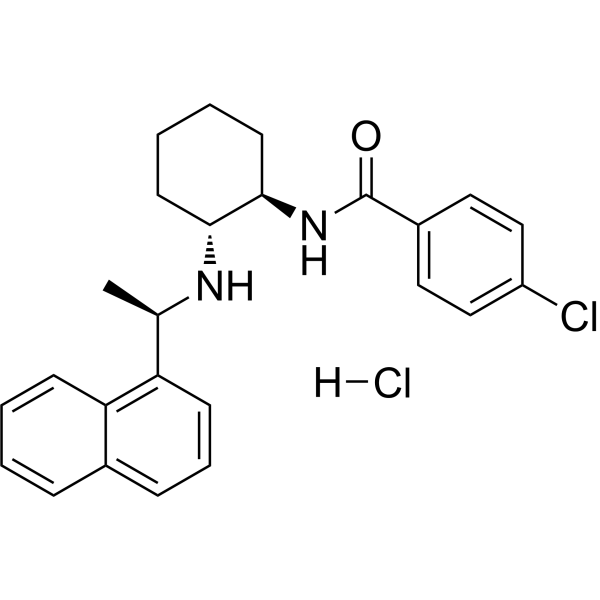
-
- HY-B0573BS
-
|
|
Adrenergic Receptor
|
Cardiovascular Disease
Neurological Disease
Endocrinology
|
|
Propranolol-d7 is the deuterium labeled Propranolol. Propranolol is a nonselective β-adrenergic receptor (βAR) antagonist, has high affinity for the β1AR and β2AR with Ki values of 1.8 nM and 0.8 nM, respectively[1]. Propranolol inhibits [3H]-DHA binding to rat brain membrane preparation with an IC50 of 12 nM[2]. Propranolol is used for the study of hypertension, pheochromocytoma, myocardial infarction, cardiac arrhythmias, angina pectoris, and hypertrophic cardiomyopathy[3].
|
-
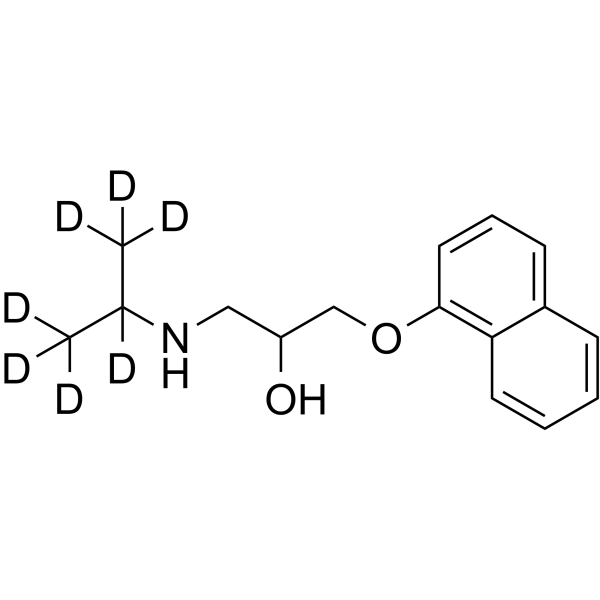
-
- HY-B0573S
-
|
|
|
|
|
Propranolol-d7 (hydrochloride) is a deuterium labeled Propranolol hydrochloride. Propranolol hydrochloride is a nonselective β-adrenergic receptor (βAR) antagonist, has high affinity for the β1AR and β2AR with Ki values of 1.8 nM and 0.8 nM, respectively[1]. Propranolol hydrochloride inhibits [3H]-DHA binding to rat brain membrane preparation with an IC50 of 12 nM[2]. Propranolol hydrochloride is used for the study of hypertension, pheochromocytoma, myocardial infarction, cardiac arrhythmias, angina pectoris, and hypertrophic cardiomyopathy[3].
|
-

-
- HY-B0573S1
-
|
|
Adrenergic Receptor
|
Neurological Disease
Endocrinology
|
|
Propranolol-d7 (ring-d7) is the deuterium labeled Propranolol hydrochloride. Propranolol hydrochloride is a nonselective β-adrenergic receptor (βAR) antagonist, has high affinity for the β1AR and β2AR with Ki values of 1.8 nM and 0.8 nM, respectively[1]. Propranolol hydrochloride inhibits [3H]-DHA binding to rat brain membrane preparation with an IC50 of 12 nM[2]. Propranolol hydrochloride is used for study of hypertension, pheochromocytoma, myocardial infarction, cardiac arrhythmias, angina pectoris, and hypertrophic cardiomyopathy[3].
|
-
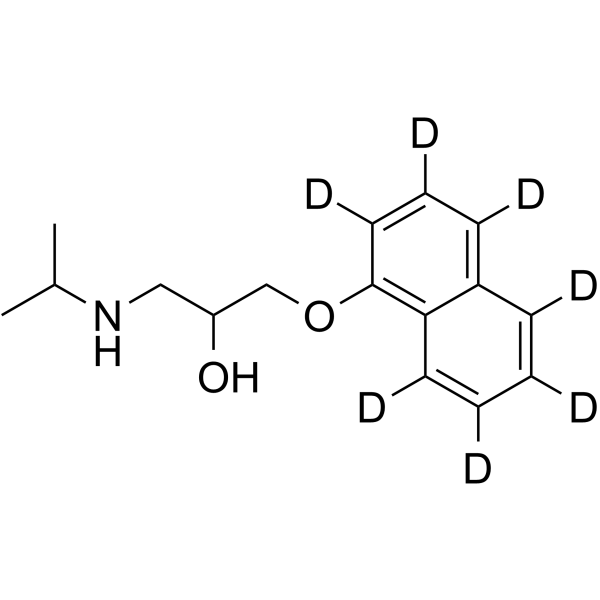
-
- HY-110067
-
-

-
- HY-115704
-
|
|
Others
|
Others
|
|
Butyryl-L-carnitine chloride is an acylcarnitine that can be isolated from Plasma/Serum .
|
-
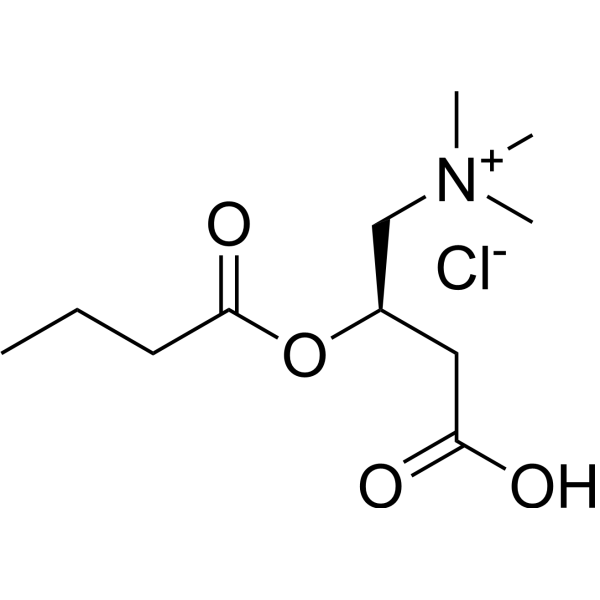
-
- HY-117772
-
-
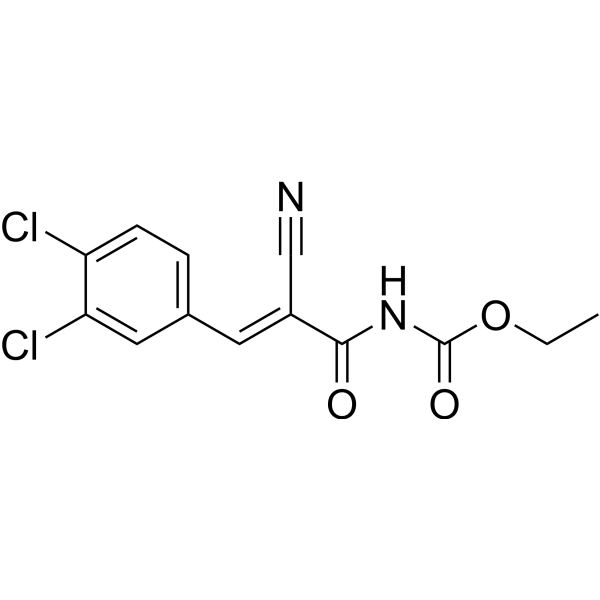
-
- HY-18204A
-
|
LCZ696
|
Angiotensin Receptor
Neprilysin
Apoptosis
|
Cardiovascular Disease
Endocrinology
Cancer
|
|
Sacubitril/Valsartan (LCZ696), comprised Valsartan and Sacubitril (AHU377) in 1:1 molar ratio, is a first-in-class, orally bioavailable, and dual-acting angiotensin receptor-neprilysin (ARN) inhibitor for hypertension and heart failure . Sacubitril/Valsartan ameliorates diabetic cardiomyopathy by inhibiting inflammation, oxidative stress and apoptosis .
|
-
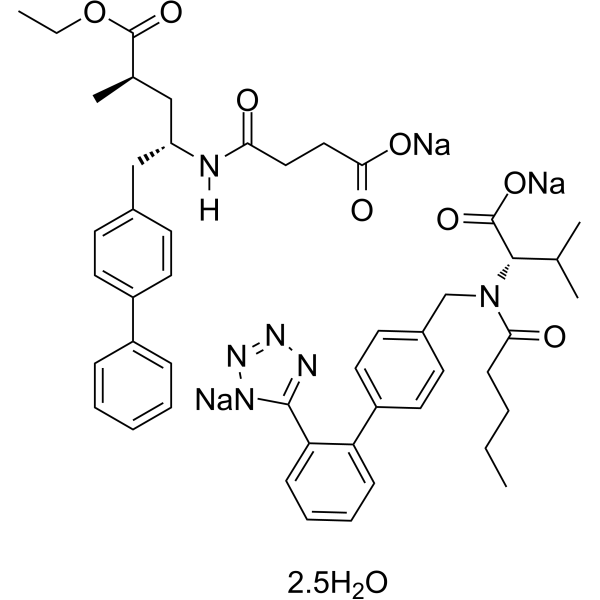
-
- HY-B0573A
-
|
|
|
|
|
(S)-(-)-Propranolol hydrochloride is a β-adrenergic receptor antagonist with log Kd values of -8.16, -9.08, and -6.93 for β1, β2, and β3, respectively. (S)-(-)-Propranolol hydrochloride the active enantiomer of propranolol and can be s used for study of hypertension, pheochromocytoma, myocardial infarction, cardiac arrhythmias, angina pectoris, and hypertrophic cardiomyopathy .
|
-
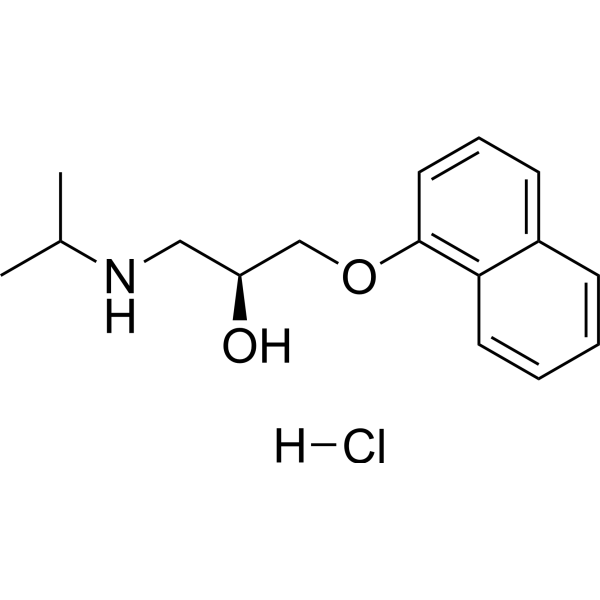
-
- HY-14858
-
|
SLV 320
|
Adenosine Receptor
|
Cardiovascular Disease
|
|
Derenofylline (SLV 320) is a potent, selective and orally active adenosine A1 receptor antagonist, with Ki values of 1 nM, 200 nM and 398 nM for human A1, A3 and A2A receptors respectively. Derenofylline suppresses cardiac fibrosis and attenuates albuminuria without affecting blood pressure in rats .
|
-
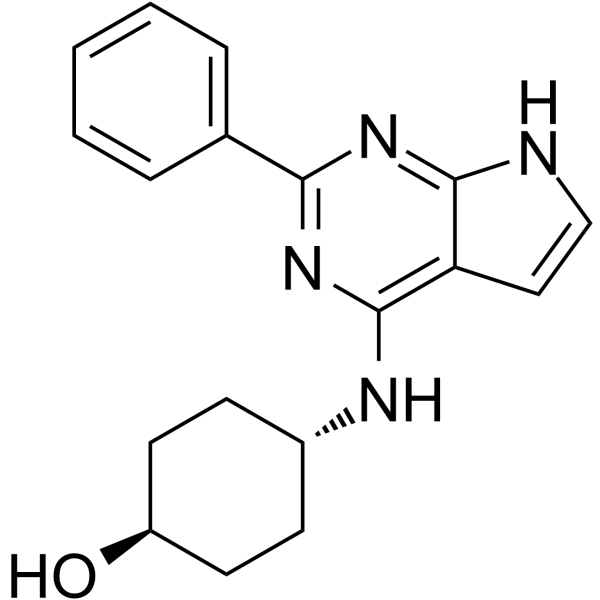
-
- HY-119678
-
|
|
AMPK
Keap1-Nrf2
|
Cardiovascular Disease
Metabolic Disease
|
|
Fortunellin, is a flavonoid, that can be isolated from the fruits of Fortunella margarita (kumquat). Fortunellin exhibits little toxicity to mice and suppresses inflammation and ROS generation in H9C2 cells induced by LPS. Fortunellin protects against fructose-induced inflammation and oxidative stress by enhancing AMPK/Nrf2 pathway. Fortunellin can be used for diabetic cardiomyopathy research .
|
-

-
- HY-B0573
-
|
|
Adrenergic Receptor
Bacterial
|
Neurological Disease
Endocrinology
Cancer
|
|
Propranolol hydrochloride is a nonselective β-adrenergic receptor (βAR) antagonist, has high affinity for the β1AR and β2AR with Ki values of 1.8 nM and 0.8 nM, respectively . Propranolol hydrochloride inhibits [ 3H]-DHA binding to rat brain membrane preparation with an IC50 of 12 nM . Propranolol hydrochloride is used for study of hypertension, pheochromocytoma, myocardial infarction, cardiac arrhythmias, angina pectoris, and hypertrophic cardiomyopathy .
|
-

-
- HY-B0573B
-
|
|
Adrenergic Receptor
Bacterial
|
Cardiovascular Disease
Neurological Disease
Endocrinology
Cancer
|
|
Propranolol is a nonselective β-adrenergic receptor (βAR) antagonist, has high affinity for the β1AR and β2AR with Ki values of 1.8 nM and 0.8 nM, respectively . Propranolol inhibits [ 3H]-DHA binding to rat brain membrane preparation with an IC50 of 12 nM . Propranolol is used for the study of hypertension, pheochromocytoma, myocardial infarction, cardiac arrhythmias, angina pectoris, and hypertrophic cardiomyopathy .
|
-
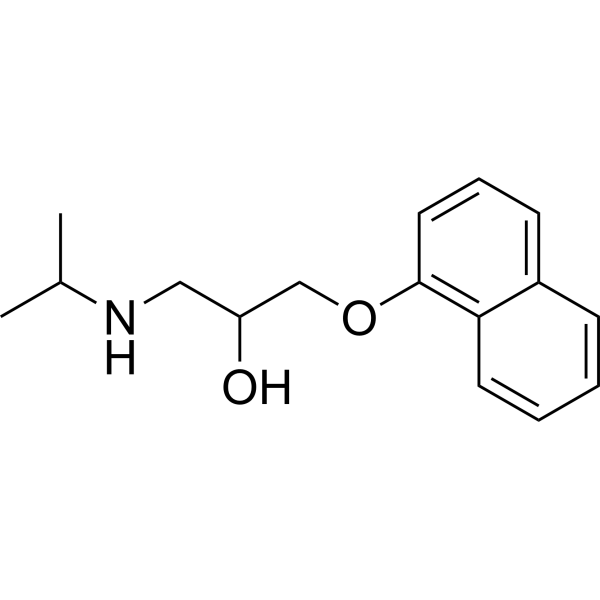
-
- HY-116364
-
|
3'-Azido-3'-deoxythymidine-5'-triphosphate
|
HIV
DNA/RNA Synthesis
HBV
Reactive Oxygen Species
Apoptosis
|
Infection
|
|
AZT triphosphate (3'-Azido-3'-deoxythymidine-5'-triphosphate) is a active triphosphate metabolite of Zidovudine (AZT). AZT triphosphate exhibits antiretroviral activity and inhibits replication of HIV. AZT triphosphate also inhibits the DNA polymerase of HBV. AZT triphosphate activates the mitochondria-mediated apoptosis pathway .
|
-

-
- HY-116364A
-
|
3'-Azido-3'-deoxythymidine-5'-triphosphate TEA
|
HIV
DNA/RNA Synthesis
HBV
Reactive Oxygen Species
Apoptosis
|
Infection
|
|
AZT triphosphate (3'-Azido-3'-deoxythymidine-5'-triphosphate) TEA is a active triphosphate metabolite of Zidovudine (AZT). AZT triphosphate TEA exhibits antiretroviral activity and inhibits replication of HIV. AZT triphosphate TEA also inhibits the DNA polymerase of HBV. AZT triphosphate TEA activates the mitochondria-mediated apoptosis pathway .
|
-
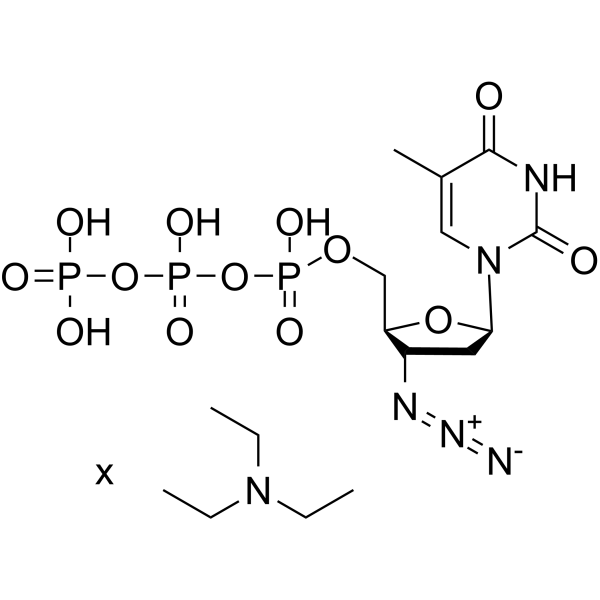
-
- HY-116364B
-
|
3'-Azido-3'-deoxythymidine-5'-triphosphate tetraammonium
|
HIV
DNA/RNA Synthesis
HBV
Reactive Oxygen Species
Apoptosis
|
Infection
|
|
AZT triphosphate (3'-Azido-3'-deoxythymidine-5'-triphosphate) tetraammonium is an active triphosphate metabolite of Zidovudine (AZT). AZT triphosphate tetraammonium exhibits antiretroviral activity and inhibits replication of HIV. AZT triphosphate tetraammonium also inhibits the DNA polymerase of HBV. AZT triphosphate tetraammonium activates the mitochondria-mediated apoptosis pathway .
|
-

-
- HY-N7627
-
|
|
Others
|
Cardiovascular Disease
Inflammation/Immunology
|
|
Regaloside C is a glycerol glucoside isolated from the bulbs of Lilium genus with anti-inflammatory activities. Regaloside C has cardiomyocyte protective activity by protecting the mitochondria in H2O2-induced heart H9C2 cells .
|
-
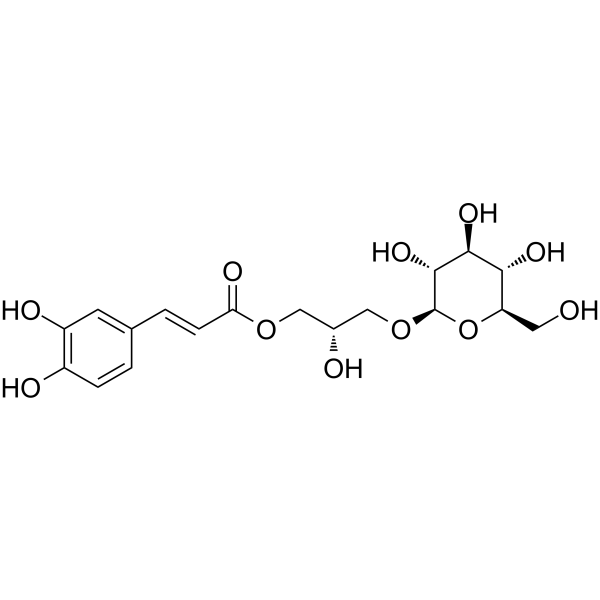
-
- HY-148089
-
|
|
Transthyretin (TTR)
|
Neurological Disease
|
|
Eplontersen is a triantennary N-acetyl galactosamine (GalNAc3-7a)-conjugated antisense oligonucleotide targeting transthyretin (TTR) mRNA to inhibit production of both variant and wild-type TTR protein. Misfolded TTR induces amyloid fibrils formation in the heart and peripheral nerves, leads to amyloid TTR (ATTR) amyloidosis diseases .
|
-

-
- HY-148089A
-
|
|
Transthyretin (TTR)
|
Neurological Disease
|
|
Eplontersen sodium is a triantennary N-acetyl galactosamine (GalNAc3-7a)-conjugated antisense oligonucleotide targeting transthyretin (TTR) mRNA to inhibit production of both variant and wild-type TTR protein. Misfolded TTR induces amyloid fibrils formation in the heart and peripheral nerves, leads to amyloid TTR (ATTR) amyloidosis diseases .
|
-
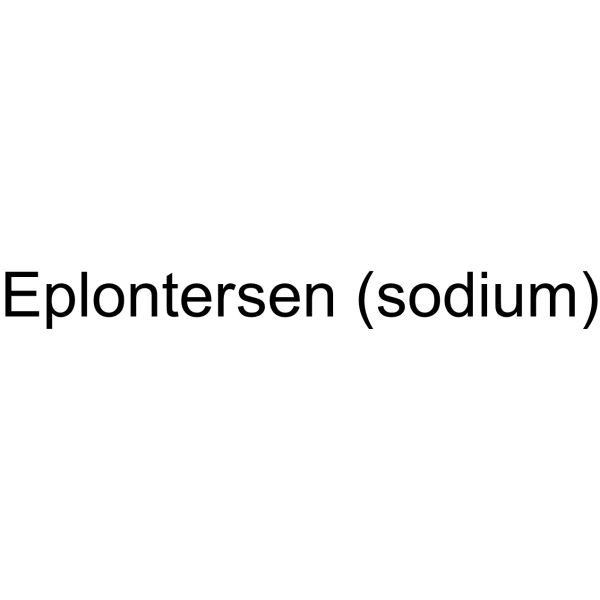
| Cat. No. |
Product Name |
Target |
Research Area |
-
- HY-P10023
-
|
|
Peptides
|
Cancer
|
|
Evuzamitide is a diagnostic imaging agent. Evuzamitide as a pan-amyloid radiotracer binding to amyloid deposits from multiple amyloidogenic proteins. Evuzamitide can be used for the research of early diagnosis of amyloid cardiomyopathy (CMP) and monitoring .
|
-
- HY-P3500
-
|
|
Peptides
|
Cardiovascular Disease
|
|
Vasomera is a stable long-acting vasoactive intestinal peptide (VIP) agonist. Vasomera acts on the G-protein-coupled VPAC2-receptors. Vasomera can be used for the research of cardiomyopathy associated with dystrophinopathies .
|
| Cat. No. |
Product Name |
Category |
Target |
Chemical Structure |
| Cat. No. |
Compare |
Product Name |
Species |
Source |
Compare Products
|
| Products |
|
| Cat. No. |
|
| Species |
|
| Source |
|
| Tag |
|
| Accession |
|
| Gene ID |
|
| Molecular Weight |
|
| Purity |
|
| Endotoxin Level |
|
| Biological Activity |
|
| Appearance |
|
| Formulation |
|
| Storage & Stability |
|
| Shipping |
|
| Free Sample |
Yes
No
|
| Size |
* This product has been "discontinued".
Optimized version of product available:
|
| Cat. No. |
Product Name |
Chemical Structure |
-
- HY-B0573BS
-
|
|
|
Propranolol-d7 is the deuterium labeled Propranolol. Propranolol is a nonselective β-adrenergic receptor (βAR) antagonist, has high affinity for the β1AR and β2AR with Ki values of 1.8 nM and 0.8 nM, respectively[1]. Propranolol inhibits [3H]-DHA binding to rat brain membrane preparation with an IC50 of 12 nM[2]. Propranolol is used for the study of hypertension, pheochromocytoma, myocardial infarction, cardiac arrhythmias, angina pectoris, and hypertrophic cardiomyopathy[3].
|
-

-
- HY-B0573S1
-
|
|
|
Propranolol-d7 (ring-d7) is the deuterium labeled Propranolol hydrochloride. Propranolol hydrochloride is a nonselective β-adrenergic receptor (βAR) antagonist, has high affinity for the β1AR and β2AR with Ki values of 1.8 nM and 0.8 nM, respectively[1]. Propranolol hydrochloride inhibits [3H]-DHA binding to rat brain membrane preparation with an IC50 of 12 nM[2]. Propranolol hydrochloride is used for study of hypertension, pheochromocytoma, myocardial infarction, cardiac arrhythmias, angina pectoris, and hypertrophic cardiomyopathy[3].
|
-

| Cat. No. |
Product Name |
Application |
Reactivity |
-
- HY-P81144
-
|
troponin I type 3 (cardiac); Cardiac troponin I; Troponin I, cardiac muscle; Cardiomyopathy, familial hypertrophic, 7, included; CMD1FF; CMD2A; CMH7; cTnI; Familial hypertrophic Cardiomyopathy 7; MGC116817; RCM1; Tn1; Tni; TNN I3; TNNC 1; TNNC-1; TNNC1; TNNI3; Troponin I cardiac; Troponin I cardiac muscle; Troponin I cardiac muscle isoform; Troponin I type 3 cardiac; troponin I, cardiac 3; TroponinI; Troponin I; TNNI3_HUMAN.
|
ELISA; IHC-P; IHC-F; IF
|
Mouse(predicted: Human, Rat, Dog, Pig, Cow, Rabbit) |
|
Cardiac Troponin I/TNNC1 Antibody is an unconjugated, approximately 23 kDa, rabbit-derived, anti-Cardiac Troponin I/TNNC1 polyclonal antibody. Cardiac Troponin I/TNNC1 Antibody can be used for: ELISA, IHC-P, IHC-F, IF expriments in mouse, and predicted: human, rat, dog, pig, cow, rabbit background without labeling.
|
Your information is safe with us. * Required Fields.
Inquiry Information
- Product Name:
- Cat. No.:
- Quantity:
- MCE Japan Authorized Agent:







































